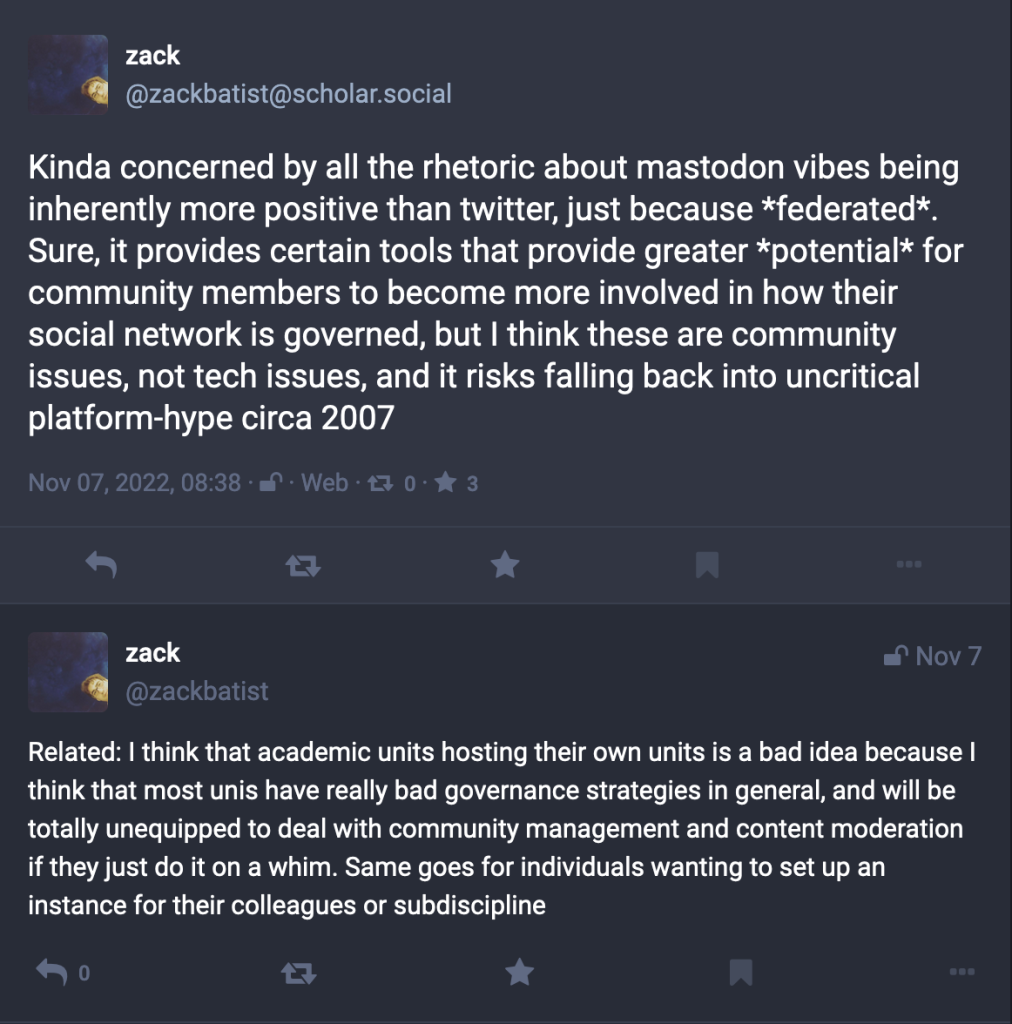So I think I finally understand LaTeX. Of course there’s still a lot for me to learn, but I think I’m at a point where I am really harnessing its true value.
I’ve been working with plaintext since I started writing my dissertation. Until very recently my workflow closely resembled an RMarkdown setup, and largely corresponded with this guide written by Ben Marwick. My simple understanding is that Pandoc passes the Markdown through LaTeX to produce a viable PDF, which makes it possible to scatter LaTeX throughout the content and in the YAML front matter. So I had a mish-mash of both Markdown and LaTeX conventions in most of my documents. For instance, I was using the comprehensive graphicx package to render my figures and I was referring to endnotes stored in a separate tex file using the sepfootnotes package, all while using Pandoc’s citeproc bibliographic referencing system. Eventually I came to realize that my workflow was fundamentally built upon LaTeX, or comprises functions that closely correlate with common LaTeX macros.
I worked using this hybrid Markdown/LaTeX setup for years, until last week when I was prompted by a member of my supervisory committee to compile a unified document so he could better understand the flow of my thesis. I had anticipated that I would need to convert everything to pure LaTeX at some point, and it was as good a time as any.
Previously, I had mashed together code from various Stack Overflow posts in order to generate something functional, but it’s a completely different experience when you start from scratch. I started by following the Overleaf guide on how to structure a thesis using LaTeX, and now I have a very robust and elegant setup that compiles a single, tidy, and systematic PDF from multiple sources. Here’s the current state of my main tex file:
% Page layout %
\documentclass{report}
\usepackage[margin=1in]{geometry}
% Line and paragraph spacing %
\usepackage{setspace}
\doublespacing
\setlength{\lineskip}{3.5pt}
\setlength{\lineskiplimit}{2pt}
\setlength{\parindent}{20pt}
% Table of contents %
\usepackage{tocloft}
\setlength{\cftbeforesecskip}{4pt}
\usepackage[page,titletoc,title]{appendix}
% Verbatim %
\usepackage{fvextra}
\DefineVerbatimEnvironment{Highlighting}{Verbatim}{breaklines,commandchars=\\\{\},breaksymbol=}
% Data references %
\usepackage{sepfootnotes}
\newendnotes{x}
\newendnotes{y}
\newendnotes{z}
\input{refs/XXXX-refs.tex}
\input{refs/YYYY-refs.tex}
\input{refs/ZZZZ-refs.tex}
\input{refs/misc-refs.tex}
\renewcommand\thexnote{A\arabic {xnote}}
\renewcommand\theynote{B\arabic {ynote}}
\renewcommand\theznote{C\arabic {znote}}
\usepackage[multiple]{footmisc}
% Figures and text boxes %
\usepackage{graphicx}
\graphicspath{{images/}}
\usepackage[font=footnotesize,labelfont=bf]{caption}
\usepackage{float}
\usepackage{mdframed}
\mdfdefinestyle{quotes}{
linecolor=black,linewidth=1pt,
leftmargin=1cm,rightmargin=1cm,
skipabove=12pt,skipbelow=12pt
}
% Block quotes %
\usepackage{csquotes}
% Tables %
\usepackage{tabularx}
% Epigraph %
\usepackage{epigraph}
\setlength{\epigraphwidth}{4in}
\renewcommand{\textflush}{flushright}
\renewcommand{\epigraphsize}{\footnotesize}
\setlength\epigraphrule{1pt}
% Bibliographic citations %
\usepackage[
citestyle=authoryear,
bibstyle=authoryear,
maxcitenames=2,
maxbibnames=99,
uniquelist=false,
date=year,
url=false
]{biblatex}
\addbibresource{/Users/zackbatist/Dropbox/zotero/zack.bib}
\renewcommand*{\postnotedelim}{\addcolon\space}
\DeclareFieldFormat{postnote}{#1}
\DeclareFieldFormat{multipostnote}{#1}
% Hyperlinks %
\usepackage[colorlinks=true]{hyperref}
\hypersetup{
linkcolor=black,
citecolor=blue,
urlcolor=blue
}
% Title page %
\title{
{Thesis Title}\\
{\large University of Toronto}\\
{\normalsize Faculty of Information}\\
% {\includegraphics{university.jpg}}
}
\author{Zack Batist}
\date{\today}
\begin{document}
\maketitle
% Front matter %
% \chapter*{Abstract}
% \chapter*{Dedication}
% \chapter*{Declaration}
% \chapter*{Acknowledgements}
\tableofcontents
\listoffigures
\listoftables
% Content %
\chapter{Introduction}
\input{chapters/introduction.tex}
\chapter{Notions of Archaeological Data}
\input{chapters/notions-of-archaeological-data.tex}
\chapter{Theories of Discursive Action}
\input{chapters/theories-of-discursive-action.tex}
\chapter{Methods}
\input{chapters/methods.tex}
\chapter{Social Worlds}
\input{chapters/social-worlds.tex}
\chapter{Sites of Discursive Negotiation}
\input{chapters/sites-of-discursive-negotiation.tex}
\chapter{Sociotechnical Tensions Relating to Data}
\input{chapters/sociotechnical-tensions-relating-to-data.tex}
\chapter{Discussion / Future Directions}
(in progress)
% Bibliograpy %
\printbibliography[heading=bibintoc]
% Appendices %
\begin{appendices}
\chapter{Summary of Code System}
\chapter{Data Management Protocols}
\chapter{Open Data Supplement}
\section{Case A}
\thexnotes
\section{Case B}
\theynotes
\section{Case C}
\theznotes
\end{appendices}
\end{document}
A large part of this work involves figuring out trends in the package ecosystem. I really struggled to differentiate between the various packages for bibliographic formatting, footnotes, figures and floats and their cross-compatibility. Some packages seem to be developed according to common tendencies, sort of like the R Tidyverse (in the sense of holding a generally common syntax, not in terms of cult behaviour), based around central cores such as biblatex and hyperref.
I’ve also been using LaTeX to format my CV, and today I started using it to create slides for an upcoming conference presentation. I like how programmatic the CV feels — you script a macro once, call the function along with the text you want it to parse, and you got a pretty little table of all your career accomplishments! I’m still kind of undecided about using beamer for conference slides, but I do like how it encourages me to write concurrently as I create the slides.

